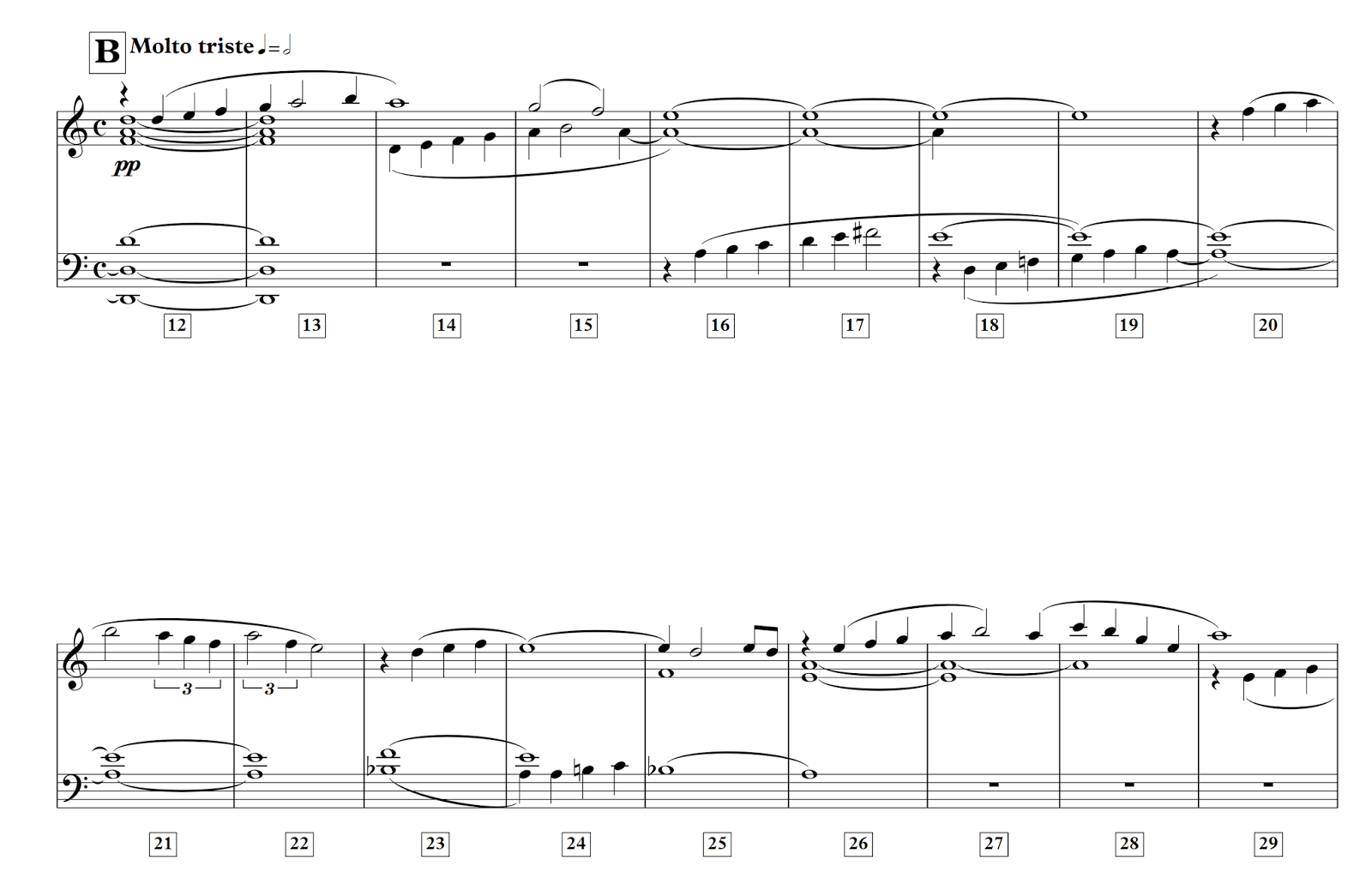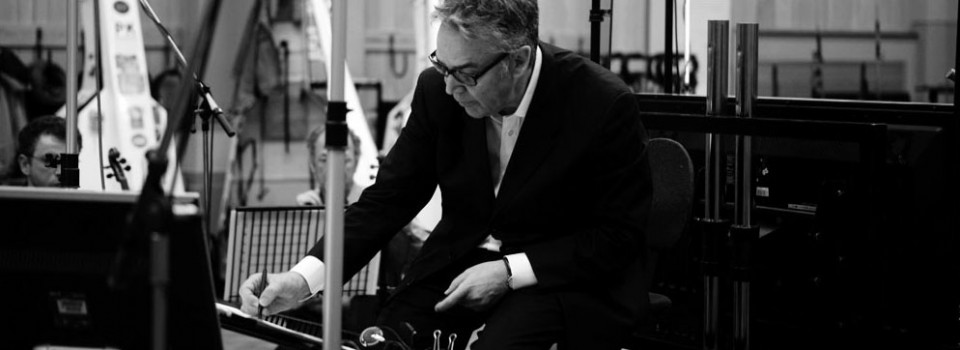With the concluding part of my analysis
of Bernard Herrmann's score for 'Walking Distance', I would like to
concentrate on his orchestration. Herrmann himself was a great
believer that every composer working on films should orchestrate his
own music as this quote of him illustrates:
'To orchestrate is like a thumbprint. I can't understand having someone else do it. It would be like someone putting color to your paintings.'
And indeed, he orchestrated every work
of his until his death.
That tells me that he valued orchestration as an important tool in order to communicate the music to the audience. I try to highlight some of his methods in this blog entry.
That tells me that he valued orchestration as an important tool in order to communicate the music to the audience. I try to highlight some of his methods in this blog entry.
Firstly, it should be noted that the ensemble used for this score was a very small one consisting of harp and a string section only. Even the string section is relatively small with 6 violins I, 4 violins II, 3 violas, 3 cellos and 2 basses. The reason for this could be an artistic one as the music almost exclusively portraits a single character and would therefore benefit of being confined to a few instruments or a small ensemble. Another reason, the one I believe to be the more likely, is that the budget for the music was limited and a small ensemble was all they could afford. Either way, the score offers a fascinating insight into Herrmann's approach for writing for such a small ensemble, especially bearing in mind that he wrote a similar score (albeit only for strings) a year later with 'Psycho'.
 |
| Intro |
The
second cue shows how to effectively use the harp to great effect. In
bars 4-5 [0:57], the strings hold an E7(b5)/Bb chord as a pad for the
harp to play a downward arpeggio of an E7. The tonal qualities of the
harp create a sense of foreboding and danger. Note also, how the
chord doesn't change (although the voicing does) but the notes for
the individual string sections do – a subtle detail to make the parts
more interesting.
The
third cue ('Memories'), illustrates one of the cornerstones of Herrmann's compositional as well as orchestral style: the development of motifs.
In the opening two bars [1:37], he scores the 'memory motif' for
violins (violins II and first desk of violins I an octave apart
with the second desk of violins I a third below) with cellos and
violas for the chord pad. For the return of the motif in bars 15 –
16 [2:39], he scores it in a much lighter texture with violins
only for the theme and chord pad.
In bar 19, he introduces cellos (note that they are playing the chord tutti now) and double basses to clearly define the chord as A minor, to then add a harp arpeggio (with the same effect as in the previous cue) in Ab major in second inversion. I have highlighted the violas, that support the harp only ever so slightly with the same chord played flautando, the effect gained is hauntingly chilling.
In bar 19, he introduces cellos (note that they are playing the chord tutti now) and double basses to clearly define the chord as A minor, to then add a harp arpeggio (with the same effect as in the previous cue) in Ab major in second inversion. I have highlighted the violas, that support the harp only ever so slightly with the same chord played flautando, the effect gained is hauntingly chilling.
 |
| Memories |
In 'The Park' [4:27], Herrmann offers
us an interesting approach of scoring a simple waltz theme. The harp
plays the basic accompaniment, while the second desks of violins I
and II play tonic and dominant harmonics respectively. The first
desks play the same harmonics but twice as fast as the second
desks. The remaining two first violins, play the theme a third apart
to complete the whole texture. Once again, the scoring here is very
light and thin but at the same time creates a sort of carefree
atmosphere.
 |
| The House |
The opening bars of 'The
Merry-go-round' [10:24] shows one of the very few instances where the
violins are not to be played with mutes. The motif is represented by
violins I at first before answered an octave lower by violins II. The
dynamic of ff and the tempo marking indicate that a harsh
and intense sound is desired. Once again although repetitive, Herrmann
makes each part more interesting by throwing phrases around and thus
keeping the sections but also the listener entertained.
 |
| The Merry-go-round |
For the final example I want to go back
to what I was pointing out in the third cue: the development of
motifs.
Section A [11:50] shows the initial chord motif, divided onto all string sections apart from double basses, playing with the same rhythm. At section B [12:34], the meter changes and basses are now introduced, to play a pedal D along with the cellos. The chord theme is now divided onto violas and violins. The melodic rhythm has now changed and is much more elaborate. At section C [0:01 second video] (the beginning of the 'Elegy' cue), the pedal D has gone, the meter is back to where it was but the whole theme is condensed to strings alone. Section D [0:48], represents even more condensing. Back is the pedal D and the change in meter but this time everything is scored for cellos and violas only.
I hope it can be seen how Herrmann was able to alter the tone and character of the same music by the use of (sometime subtle) variations throughout his orchestration. This, I believe, is the key to the success and popularity of his music as it rarely becomes tiring although being incredibly repetitive.
Section A [11:50] shows the initial chord motif, divided onto all string sections apart from double basses, playing with the same rhythm. At section B [12:34], the meter changes and basses are now introduced, to play a pedal D along with the cellos. The chord theme is now divided onto violas and violins. The melodic rhythm has now changed and is much more elaborate. At section C [0:01 second video] (the beginning of the 'Elegy' cue), the pedal D has gone, the meter is back to where it was but the whole theme is condensed to strings alone. Section D [0:48], represents even more condensing. Back is the pedal D and the change in meter but this time everything is scored for cellos and violas only.
I hope it can be seen how Herrmann was able to alter the tone and character of the same music by the use of (sometime subtle) variations throughout his orchestration. This, I believe, is the key to the success and popularity of his music as it rarely becomes tiring although being incredibly repetitive.
This concludes my blog about Bernard Herrmann's orchestration for the score to 'Walking Distance' and indeed my 3 part blog series about the score itself. I hope you found it interesting and informative but also motivating to explore more of Herrmann's music, as there is much to be learnt from it.
-PW
These transcriptions are entirely my own and only intended for educational purposes.












%2B-%2BTZ%2B-%2BWalking%2BDistance.png)




















